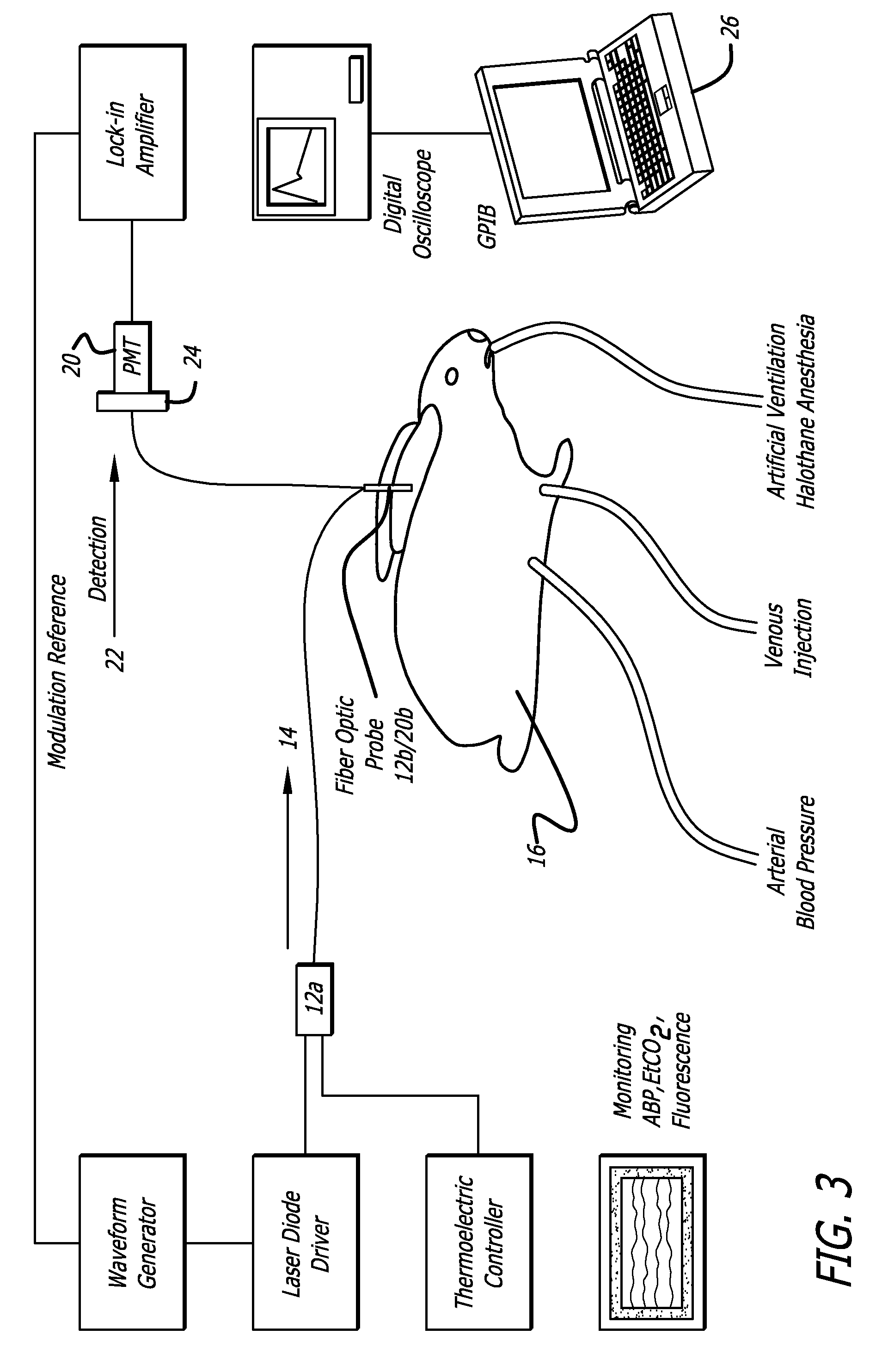Measurement of cardiac output and blood volume by non-invasive detection of indicator dilution for hemodialysis
a technology of indicator dilution and cardiac output, which is applied in the field of detection of parameters of the cardiovascular system, can solve the problem of minimal invasiveness, achieve the effect of improving the measurement of cardiovascular parameters, increasing blood flow, and improving the accuracy of indicator emission measuremen
- Summary
- Abstract
- Description
- Claims
- Application Information
AI Technical Summary
Benefits of technology
Problems solved by technology
Method used
Image
Examples
example 1
[0167]Experimental system and method. An implementation of the system and method of the cardiovascular measurement devices and methods was tested in rats. The excitation source was a 775 nm pulsed diode laser and the fluorescence was detected with a detector being a photomultiplier (PMT) with extended response in the near-infrared range of the spectrum (FIG. 1). Optic fibers were placed in close contact with the skin of the animal's ear for the excitation and detection of the indicator within the blood stream. After injection of a 100 μl bolus of ICG (0.0075 mg / ml) into the jugular vein of a rat, the fluorescence intensity trace (indicator concentration recording) was measured transcutaneously at the level of the rat's ear using reflection mode detection of emissions (FIG. 2).
[0168]Calculation of Blood Volume and Cardiac Output.
[0169]The initial rapid rise and rapid decay segments of the fluorescence intensity trace represent the first pass of the fluorescent indicator in the arteri...
example 2
[0175]A. A sample method and system for measuring cardiac output and blood volume. Experiments have been performed in New Zealand White rabbits (2.8-3.5 Kg) anesthetized with halothane and artificially ventilated with an oxygen-enriched gas mixture (Fio2˜0.4) to achieve a Sao2 above 99% and an end-tidal CO2 between 28 and 32 mm Hg (FIG. 4). The left femoral artery was cannulated for measurement of the arterial blood pressure throughout the procedure. A small catheter was positioned in the left brachial vein to inject the indicator, ICG. Body temperature was maintained with a heat lamp.
[0176]Excitation of the ICG fluorescence was achieved with a 780 nm laser (LD head: Microlaser systems SRT-F780S-12) whose output was sinusoidally modulated at 2.8 KHz by modulation of the diode current at the level of the laser diode driver diode (LD Driver: Microlaser Systems CP 200) and operably connected to a thermoelectric controller (Microlaser Systems: CT15W). The near-infrared light output was ...
example 3
Comparison with Thermodilution Method
[0214]Experimental methodology. Other experiments were performed in New Zealand White rabbits using the methodology described for the preceding example 2. In addition, a 4F thermodilution balloon catheter was inserted into the right femoral vein and advanced until the thermistor reached the main pulmonary artery. Correct placement of the catheter tip was verified visually through the thoracotomy. The catheter was connected to a cardiac output computer to measure the thermodilution cardiac output. Cardiac output measurements were obtained with the present method (COICG) and the comparison thermodilution method (COTD) during baseline conditions, reduced flow conditions resulting from vagal stimulation, and increased flow conditions resulting from blood volume expansion with saline.
[0215]Results.
[0216]Average values of COICG and COTD measured in baseline conditions in the 10 animals were 412 (±13) ml / min and 366 (±11) ml / min, respectively, in the ex...
PUM
 Login to View More
Login to View More Abstract
Description
Claims
Application Information
 Login to View More
Login to View More - R&D
- Intellectual Property
- Life Sciences
- Materials
- Tech Scout
- Unparalleled Data Quality
- Higher Quality Content
- 60% Fewer Hallucinations
Browse by: Latest US Patents, China's latest patents, Technical Efficacy Thesaurus, Application Domain, Technology Topic, Popular Technical Reports.
© 2025 PatSnap. All rights reserved.Legal|Privacy policy|Modern Slavery Act Transparency Statement|Sitemap|About US| Contact US: help@patsnap.com



